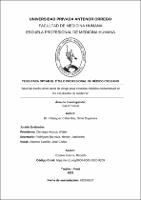Mostrar el registro sencillo del ítem
Nivel de estrés como factor de riesgo para trastorno disfórico premenstrual en las estudiantes de medicina
| dc.contributor.advisor | Rosales García, Roberto | |
| dc.contributor.author | Velásquez Cabanillas, Silvia Dayanara | |
| dc.creator | Velásquez Cabanillas, Silvia Dayanara | |
| dc.date.accessioned | 2022-02-15T20:07:23Z | |
| dc.date.available | 2022-02-15T20:07:23Z | |
| dc.date.issued | 2022 | |
| dc.identifier.uri | https://hdl.handle.net/20.500.12759/8652 | |
| dc.description.abstract | Demostrar si el estrés es un factor de riesgo para el trastorno disfórico premenstrual en las estudiantes de medicina. Material y métodos: Se encuestó a 388 estudiantes de medicina que cursen entre el I y XIV ciclo académico en la Universidad Privada Antenor Orrego. Se realizó esta investigación con diseño observacional, transversal, analítico. Se usó la prueba estadística chi cuadrado y modelo logístico para verificar la significancia estadística de las asociaciones, fueron consideradas significativas si el valor de p < 0.05. Se obtuvo el OR para el estrés en cuanto a su asociación con el trastorno disfórico premenstrual, se hizo el cálculo del intervalo de confianza al 95% tanto para el estrés como para las variables intervinientes. Resultados: El nivel alto de estrés en las estudiantes con TDPM fue 71,1% y el nivel bajo de estrés fue 28,9%. La prevalencia del nivel alto de estrés en estudiantes de medicina sin TDPM fue 60,8% y el nivel bajo de estrés sin TDPM fue 39,2%. El análisis de las variables de este estudio mostró que si existe relación entre el nivel de estrés como factor de riesgo para el TDPM con un valor de p < 0,05. Se encontró que el nivel de estrés es un factor de riesgo para TDPM (p=0,047; OR=1,594) y la edad es una variable interviniente como factor protector para el TDPM (p=0,017; OR = 0,927). Conclusiones: el nivel alto de estrés presente en la formación médica es un factor de riesgo para trastorno disfórico premenstrual por lo que es importante la prevención y conocimiento de dicho trastorno. | es_PE |
| dc.description.abstract | To demonstrate whether stress is a risk factor for premenstrual dysphoric disorder in medical students. Material and methods: 388 medical students enrolled between the I and XIV academic cycle at the Antenor Orrego Private University were surveyed. This research was carried out with an observational, cross-sectional, analytical design. The chi square statistical test and the logistic model were used to verify the statistical significance of the associations, they were considered significant if the value of p < 0.05. The OR was obtained for stress in terms of its association with premenstrual dysphoric disorder, and the 95% confidence interval was calculated for both stress and the intervening variables. Results: The high level of stress in the students with PMDD was 71.1% and the low level of stress was 28.9%. The prevalence of high stress level in medical students without PMDD was 60.8% and low stress level without PMDD was 39.2%. The analysis of the variables of this study showed that there is a relationship between the level of stress as a risk factor for PMDD with a value of p < 0.05. It was found that stress level is a risk factor for PMDD (p=0.047; OR=1.594) and age is an intervening variable as a protective factor for PMDD (p=0.017; OR=0.927). Conclusions: the high level of stress present in medical training is a risk factor for premenstrual dysphoric disorder, which is why prevention and knowledge of said disorder is important | en_US |
| dc.description.uri | Tesis | es_PE |
| dc.format | application/pdf | es_PE |
| dc.language.iso | spa | es_PE |
| dc.publisher | Universidad Privada Antenor Orrego - UPAO | es_PE |
| dc.relation.ispartofseries | T_MED_3112 | |
| dc.rights | info:eu-repo/semantics/openAccess | es_PE |
| dc.rights.uri | https://creativecommons.org/licenses/by/4.0/ | es_PE |
| dc.source | Universidad Privada Antenor Orrego | es_PE |
| dc.source | Repositorio institucional - UPAO | es_PE |
| dc.subject | Trastorno Disfórico Premenstrua | es_PE |
| dc.subject | Estudiantes de Medicina | es_PE |
| dc.title | Nivel de estrés como factor de riesgo para trastorno disfórico premenstrual en las estudiantes de medicina | es_PE |
| dc.type | info:eu-repo/semantics/bachelorThesis | es_PE |
| thesis.degree.grantor | Universidad Privada Antenor Orrego. Facultad de Medicina Humana | es_PE |
| thesis.degree.name | Medico Cirujano | es_PE |
| thesis.degree.discipline | Medicina | es_PE |
| dc.subject.ocde | http://purl.org/pe-repo/ocde/ford#3.02.27 | es_PE |
| renati.advisor.orcid | https://orcid.org/0000-0003-2520-9209 | es_PE |
| renati.author.dni | 73935434 | |
| renati.advisor.dni | 18173908 | |
| renati.type | http://purl.org/pe-repo/renati/type#tesis | es_PE |
| renati.level | http://purl.org/pe-repo/renati/level#tituloProfesional | es_PE |
| renati.discipline | 912016 | es_PE |
| renati.juror | Olortegui Acosta, Walter | |
| renati.juror | Rodríguez Barboza, Héctor Uladismiro | |
| renati.juror | Chaman Castillo, José Carlos | |
| dc.publisher.country | PE | es_PE |
Ficheros en el ítem
Este ítem aparece en la(s) siguiente(s) colección(es)
-
Medicina Humana [2774]


